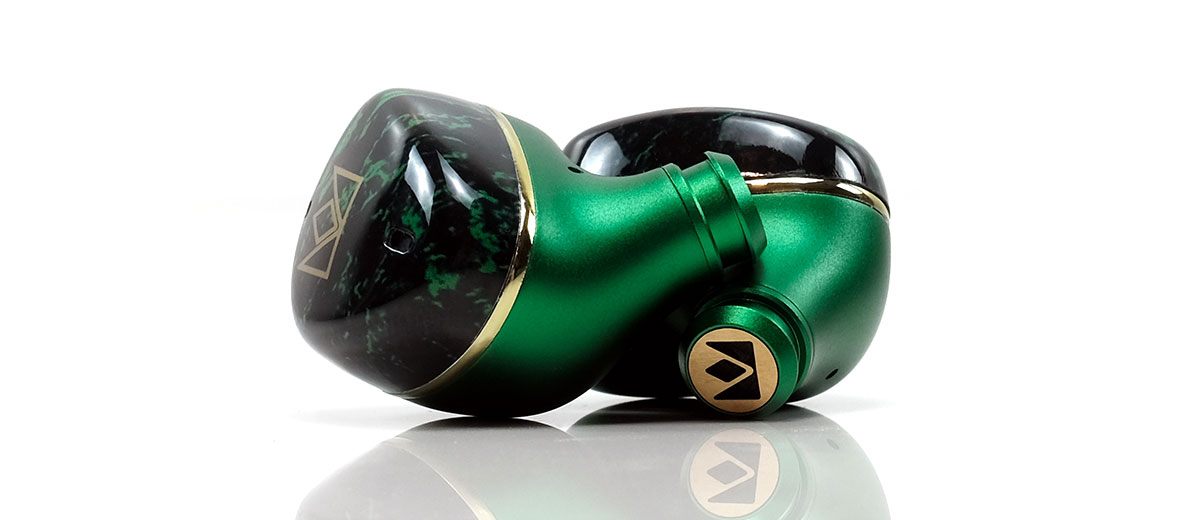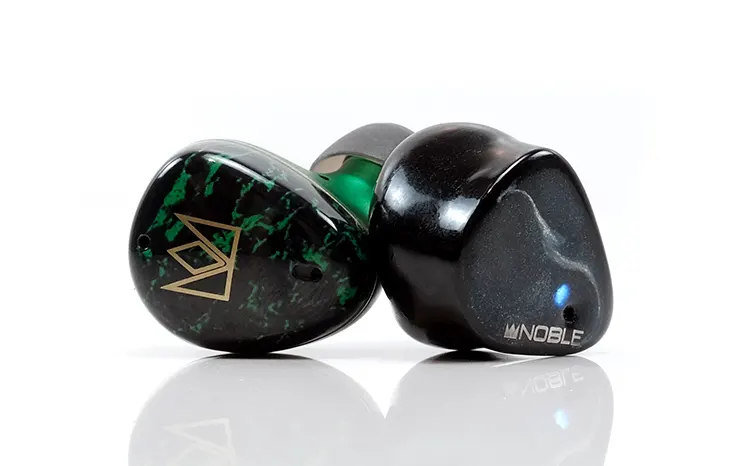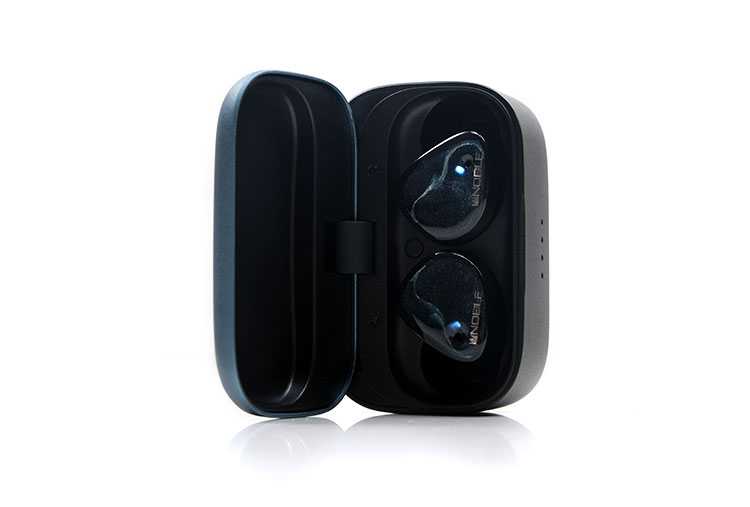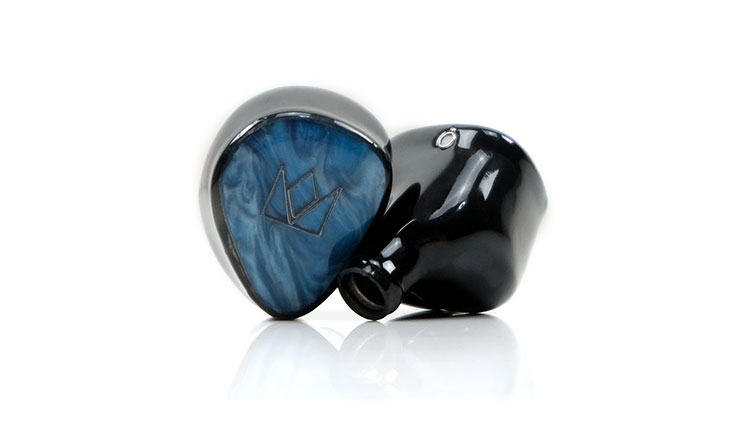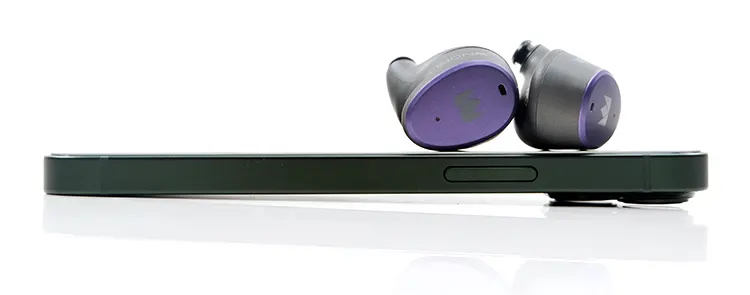Selected Comparisons
The following comparisons to the Noble FoKus Rex5 were completed using a Samsung S23 Ultra and a Cayin N6iii with the stock single flange silicone tips.
Noble Audio FoKus Mystique
The FoKus Mystique is a former flagship TWS launched by Noble in 2023. Our review came out in March of that same year.
Technical
Both units are hybrid multi-driver configurations, however, the Rex5 diversifies with a 6mm planar for the highs and a larger 10mm as opposed to an 8mm dynamic driver for the lows.
Both use BA drivers for the mids, but the precise count is slightly different, with the Rex5 using 3 for the mids and mid/highs, and the Mystique using 1 for the mid/highs and a BA instead of planar for the highs.
The Mystique mids are also covered by the 8mm dynamic driver, meaning the larger 10mm Rex5 dynamic driver is focused purely on the lows.
The FoKus Mystique also uses the older BT5.2 Qualcomm QCC3040 Bluetooth SoC, instead of the Rex5’s newer BT5.4 QCC3091. The Mystique has no ANC capability, which the Rex5 offers, and may be a deal breaker for modern TWS users.
Their respective BT performance gap between the two was negligible for latency and signal range. The GitHub Latency tester has the Mystique and Rex5 between 350-380 ms over multiple test runs.
Decoding rates are lower on the Mystique at a maximum of aptX Adaptive, with the Rex5 capable of going up to LDAC, which is where I think any modern TWS should be right now for hi-res decoding.
Both rely on the FoKus app for some additional features, such as EQ and media controls. However, with the more modern BT chipset inside the Rex 5, it can store those profiles directly on the earbuds. The Rex5 FoKus app integration also opens up the personalized Audiodo EQ features and, of course, ANC/Ambient controls.
Battery life between the two earbuds is more or less the same at 7-7.5 hours on paper, though the Rex5 drops a few hours with ANC on. The Mystique cradle has slightly more cycle charge capacity, but the difference isn’t huge.
Design
The Rex5 looks more evolved design-wise when placed next to the Mystique. The mix of greens and the central gold banding with a stronger polished finish looks more attention-grabbing than the more subdued blues and blacks of the Mystique shells
I think the Mystique design is still quite attractive, but the all-resin body feels a little sharper-edged in the hand and is not as smoothly curved as the Rex5. That aluminum shell does make the Rex5 feel a little heavier and denser, though I didn’t feel any difference in the ear due to that.
The plus side of using a resin-contoured shell is a slightly better fit in the ear for the Mystique. It does feel more secure in my ear, though the passive isolation performance is on par with the Rex5. Of course, once you turn on the ANC, the Rex5 is far superior for isolation.
I also prefer the Rex5 cradle design over the older Mystique top slot blue cradle. The strong magnets inside the top slot cradle, combined with the slippery resin finish, make the Mystique buds a little tricky to take out.
This is not an issue with the new side-slot and more compact Rex5 cradle. The buds are much easier to grasp, as well as providing more space to access the reset button between the buds. It’s also a quieter, sturdier cradle lid with less noise when closing.
Performance
It sounds like the upgraded BT SoC’s integrated amplifier is delivering better power to the Rex5 drivers than the older version inside the Mystique, because the first thing that hits you is the size of the presentation and the general loudness level.
The Rex5 is deeper, wider, and a little taller sounding than the Mystique, which sounds clean and clear but offers a politer and comparatively walled-in listening experience.
There is some power in the lows of the Rex5, which the Mystique cannot match. Conversely, the Mystique sounds a little leaner in its note composition with a weaker fundamental frequency.
The bass shelf is higher and longer on the Rex5, with ear gain a little further forward but not overly so compared to the Mystique.
What it has instead is vocal body and rhythm in the lows, giving modern pop and R’n’B much more credible weight and thrust in the performance, an area where the Mystique has a ‘pitter patter’ nature to it.
Both have a little brightness in the highs, though the Mystique is more noticeable given its slightly reduced bass weight and warmth. The FoKus Rex5 has a better balance between the lows and highs, so the tonal contrast sounds more natural as a result.
Honestly, those additional BA drivers in the Rex5 mids make a difference, especially with texture and layering. Every note sounds fuller, more resolving, and with improved texture over the Mystique equivalent.
The additional body does not come at the cost of headroom or separation, either. The Rex5 staging width and separation are far superior to what the Mystique can deliver, the enhanced power and low-end depth are clearly noticeable also.
Noble Audio FoKus Pro
The FoKus Pro was launched in 2021 and, at the time, was also a Noble Audio flagship TWS. It also won our Top Gear 2021 Award for Best TWS.
Technical
Though both are hybrid multi-driver TWS, the tech spec for the FoKus Pro is more in line with the Mystique than the Rex5.
Inside is a smaller single 8.2mm dynamic driver for the lows and mids, and a dual custom Knowles BA setup for the mid-highs and highs, as opposed to the Rex5’s 10mm dynamic driver for the lows, a triple BA, and a 6.2mm planar config for the mids and highs.
The Pro’s BT chipset is also unchanged from the Mystique, with a BT5.2-capable Qualcomm QCC3040 and a maximum decoding of up to aptX adaptive, as opposed to the Rex5’s newer BT5.4 QCC3091 and up to LDAC decoding capability.
Latency performance was quite similar at 350-380 ms, with the Rex5 offering a bit more signal stability over the FoKus Pro at extreme distances (around 20m with one wall between source and earbuds)
The Pro has no ANC, so passive isolation is more important, whereas the Rex5 will provide superior isolation with ANC but at the cost of a hit on the battery life.
Speaking of which, the Pro can deliver similar battery rates to the Rex5 with ANC turned off at 7.5 hours, over 7 hours with the Rex5 dropping to under 5 hours with ANC turned on.
The Pro used the blue cradle case, but the capacity is comparatively huge, with up to 7-8 cycles possible as opposed to just 3-4 cycles from the new Rex5 green cradle.
Both devices are integrated into the FoKus App, but the FoKus Pro lacks any of the Rex5’s ANC control, remote store custom EQ profiles, or access to the Audiodo personal EQ system.
Design
I have a similar sentiment regarding the FoKus Pro form factor and aesthetics from the Mystique comparisons. In truth, there is not a huge difference between the older models, save for the different faceplate designs and a slightly deeper nozzle on the Mystique.
That means the Rex5’s stronger jade green aesthetics have more visual pop, the aluminum materials give it a denser feel, and the contouring is not as elaborate as the FoKus Pro resin shell, meaning the older model has a slightly more secure fit in the ear.
The FoKus Pro also has a superior level of passive isolation, but it has to because it has no ANC capability. The Rex5 can get away with a leakier form factor with ANC turned on, giving it bags more isolation capability.
The FoKus Pro uses the same cradle as the Mystique, so my thoughts on this top-loading version are the same as the Mystique critique. It’s a slippery customer to quickly take out without a degree of slipping and an obscured reset button.
The Rex5’s more compact side-loading cradle fills me with more confidence that I will not be grasping multiple times to get the earbuds out of their tray quickly.
Performance
The Pro is the only previous model in the FoKus range to have a level of elevation in the low-end tuning that comes close to the FoKus Rex5 bass response.
However, in part due to the better integrated amplifier, the larger dynamic driver, and LDAC, the Pro low-end sounds far less defined than the Rex5 equivalent. This is more of a high ‘thud’, with a slightly mid-bass bias, but it sounds ‘samey’ for most notes and quite two-dimensional in its delivery.
The Rex5 has more character and textured detail in its bass delivery. A bass guitar pluck sounds like one, a kick drum thud sounds more like a real kick drum should. And there is space for each to be heard clearly, whereas the Pro sounds much more contained and boomy in comparison.
And that is sort of a theme throughout the mids and highs with those additional BA drivers and planar to play with.
You get a bigger, fleshier sound with more staging width, heightened resolution and clarity, and improved headroom from the Rex5 versus a relatively smooth but constrained and quieter sound signature from the Pro.
Even with LDAC turned off, the Rex5 can deliver a superior presentation, so it’s not just about improved decoding capability. Also, turning ANC off just elevates the Rex5 even further in terms of bass definition and detail.
Overall, the FoKus Rex5 is far more accurate and life-like in its performance than the FoKus Pro. I feel I am missing out on too much information in my music when I switch to the older Pro.
Noble Audio FoKus H-ANC
The H-ANC is by no means a direct competitor to the FoKus Rex5, but it is the only other Noble model that offers ANC, which might be a deal-maker for those looking at the brand for the first time or existing owners looking at an upgrade path.
Technical
The H-ANC is an IPX5-rated dual driver model rather than a 5-driver with a simpler single 10 mm titanium membrane dynamic for the lows and mids, and one Knowles RAN BA for the highs.
Its BT chipset is the Airoha 1562A, which is a bit behind the QCC3091 inside the Rex5. You will not get aptX or LDAC with the H-ANC and BT drops to 5.2 as opposed to 5.4. Instead, it tops out at SBC with both offering AAC for iPhones, which is a bit of a drop from the Rex5’s 24-bit/96kHz decoding capability.
The latency also suffers a little with about 100ms more latency from the H-ANC at around 450-480ms compared to 350-380ms from the Rex5 using the GitHub online test.
The stability and range of the H-ANC BT signal from an S23 Ultra pairing is competitive, though, and on par with the Rex5, at least in the confines of my 20m long office space.
Both apps have access to the FoKus app and ANC options, though the H-ANC has one additional wind noise reduction option, which is not available for the Rex5, something I wish the newer model had.
On the flip side, the H-ANC has no Audiodo personal EQ and cannot store any custom presets in the earbuds. Touch control prompts are also slightly slower than the responsive Rex5 earbud touch controls.
The H-ANC battery life is superior, though given its downsized driver config, I am not wholly surprised. You can get 12 hours without ANC as opposed to the Rex5’s 7 hours and, on paper, 8.5 hours with ANC. However, like the 5-hour rating of the Rex5 rating, it’s a bit lower in reality.
Design
The H-ANC belongs in the more traditional Noble design school with a bulkier grey plasticky shell and monotone top, albeit with varying colors, this one being purple.
It looks ungainly beside the slicker, smoother contouring of the jade green aesthetic of the Rex5. I would say the H-ANC feels quite durable, though the plastics might not be as tough as the denser aluminum shell of the Rex5.
Because it is old school, the H-ANC has a classic deeper nozzle complete with the shortened tips of which I am a big fan of. These buds can penetrate further than the Rex5 variant, but you will feel a bit more pressure in your outer ear from the shell as a result.
The plus of this depth is a superior ANC performance with more low Hz attenuation compared to the Rex5 (using single flange wide bore silicone tip). I was not expecting that from a cheaper model, but it shows how effective the long nozzle and shallow tips are for general isolation capabilities.
The supplied H-ANC cradle is definitely of a cheaper, plasticky quality; money has to be saved somewhere to get it down to its sub-$150 price point. It’s not as durable or as attractive-looking as the more compact jade green styling of the Rex5 cradle.
I will say, though, that its inner tray, whilst top-loading, does not suffer from the blue cradle slipperiness when taking out the earbuds. It also has a reset button on the back, making it very easy to access.
Performance
You get what you pay for, and this is never more true than here. Aside from the surprisingly competitive ANC performance from the H-ANC, the Rex5 stands tall over the cheaper TWS by a country mile in almost every aspect.
The ability for the FoKus Rex5 to decode at LDAC over the H-ANC’s SBC-only profile, combined with the additional drivers, makes a big difference in technical capability.
The H-ANC has a fairly lifted bass response, but it lacks the resolution and immersion of its bigger sibling, sounding relatively compressed and quite rounded in its tonal balance.
The FoKus Rex5 sounds more balanced in its presentation. It has superior extension at both ends of the frequency curve, far more headroom, and a more defined and accurate bass delivery with less of the H-ANC’s upper-bass bloom.
It creates a better sense of space through the mids with a more vivid and detailed vocal performance and more fizz and energy in its percussion timbre.
A/B’ing between these two is like listening to a balanced wired IEM presentation, then throwing a veil over everything when moving back to the cheaper model.
That might seem harsh, considering the price difference, and indeed, I find the H-ANC to be a relatively competitive entry-level TWS with ANC. However, if you are after a big step up in clarity and dynamic range, the FoKus Rex5 is a true upgrade path for H-ANC owners.
My Verdict
The Noble Audio FoKus Rex5 is certainly the best TWS I have heard this year and probably one of the best I have heard thus far. It’s a stunning mix of power, clarity, and space with excellent dynamic range and resolution for a True Wireless System.
Negative points? The ANC-On battery life fell a bit short of the official 5 hours specification, though using LDAC and FLAC hi-res tracks might be a factor in that performance. Also, the ANC performance is very good, but not class-leading, with Noble’s older, cheaper H-ANC giving it a bit of a run for its money.
Granted, the Rex5 is not a cheap offering, but I think the performance and the upgrade in build and design aesthetics go a long way to justify the price. This is likely the one TWS going in my travel bag for the foreseeable future.
Noble FoKus Rex5 Technical Specifications
- Drivers: 5 Driver configuration: (1x) 10mm Dynamic driver, (1x) 6mm Planar driver, (3x) Balanced Armature drivers
- Frequency Response: 20- 40 kHz
- Chip: QCC3091
- Bluetooth: 5.4
- Codec: SBC, AAC, aptX Adaptive, LDAC
- Multipoint Connection: 2 Devices
- Playtime: 5hrs (ANC), 7hrs (ANC/off)

